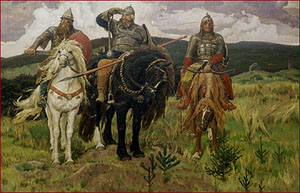Russia could certainly have used some heroic figures in 1904-05, such as these depicted by Viktor Vasnetsov (1848-1926), Bogatyri (Bogatyrs, 1898. Oil on canvas. The Tretiakov Gallery, Moscow). These three bogatyri were legendary heroes: Ilya Muromets, Dobrynya Nikitich and Aliosha Popovich. Each of the characters has his own set of legends. Though every hero had his own adventures, every one defended his land, the poor, and fought the enemies of Russia; and they were all adored by the people. Here the painter depicted them all together, guarding the Russian borders. |

|
You could argue whether what
happened in Russia in 1905 was or was not a revolution, but
most historians have tended to label it the 1905 Revolution; maybe
taking their clue from Trotksii's book, 1905 (1907), in which he continually
referred to the events of 1905 as a revolution. I have my
doubts as to whether it really was a revolution.
In some respects, it appeared as though the Russian government was doing everything it could to bring about a revolution!
OK, trouble began in 1904 when Russia got itself involved in the Russo-Japanese War,
a war which, I might add, the Russian government welcomed for the most
part; military disaster followed military disaster both on land and at
sea. There just was no way to completely
hide those catastrophes from the Russian public, which made Russians
increasingly wonder about the competency of their imperial
leadership. Remember, although Japan declared war first, it was the Russian government that really precipitated the war.
Consider also the radical (and very rapid) transformation that had been changing Russian society and the economy, in the process, creating a working class and also concentrating that working class in the political centers (Moscow, Kiev and St. Petersburg) of the country. Remember it was the Russian government that had itself decided to undertake the program of heavy industrialization to build up an industrial infrastructure to support the needs of the Russian military.
Look also what the Russian
government did with respect to the political
opposition. The tsarist secret police planted government
informers throughout all of the opposition political parties (liberals and
socialists). Then in the case of the Battle Organization of the
Socialist Revolutionary Party, those government agents, such
as Evno Azef,
carried out a series of spectacular assassinations of government
officials, such as the ministers of the interior Dmitrii Sipiagin
(1853-15/28April 1902) and Viacheslav von Pleve (1846-15/28 July 1904) and even the
tsar's uncle, the Grand Duke Sergei Aleksandrovich (1857-4/17 February
1905) . The continued assassinations helped to really destabilize the political situation in Russia.
Keep in mind
that the
Russian government also had a peculiar policy with regard to
workers. (For a long time, the government even refused to
acknowledge that
Russia had a working class!) Since worker organizations were
illegal, the Russian police tried to create their own
government-controlled workers associations, such as that in which
Father Georgii Gapon (1870-1906) became involved. That police socialism experiment lead directly to Bloody Sunday.
Finally, in October 1905,
the General
Strike, one of the most successful worker actions ever to have taken place in world history,
brought Russia to a standstill. Faced with the complete shutdown
of Russia, it was Sergei Witte who
counseled the tsar that he had to issue the October Manifesto
that made the promises of a new, "constitutional" order in Russia. Once the
strike ended and then Moscow Uprising--largely a product of the
Bolsheviks who were trying to get to the forefront of events in Russia
when the party had not played much of a role so far--was
put down (The war with Japan was already over.), Russia quieted down a bit.
In early 1906 (27 April/10 May), the day that the new Duma (Russian parliament) opened, the tsar issued Russia's new "constitution" in the guise of the Fundamental Laws. These 223 articles had been prepared by Witte and the Council of Ministers with the later participation of the tsar to make sure that everything was conservative enough. In the new "constitutional regime" the tsar reserved for himself enormous power. As a result, I am not sure how you could call the outcome of events in Russia in 1904 and 1905 a revolution?
If you are interested you can take a look at some lecture notes on 1905 (*.pdf file) from one of my former advisors at the University of Virginia, Thomas T. Hammond. When I was in graduate school there in the 1980s, Hammond had already been teaching at the University for over thirty years, and he had helped to build a very strong program of Russian studies. These lecture notes show how detail-oriented he was, and how carefully he worked on his lectures.
- Walter Sablinsky, The Road to Bloody Sunday: Father Gapon and the St. Petersburg Massacre of 1905 (1976)
- Sidney Harcave, First Blood: The Russian Revolution of 1905 (1964)
- Peter Waldron, Between Two Revolutions: Stolypin and the Politics of Renewal in Russia (1998)
- Aleksandr Zenkovsky, Stolypin: Russia's Last Great Reformer (1986)
- A lecture by the late Professor Michael Boro Petrovich on the 1905 Revolution is available on the web.
- Nicholas II on the Dissolution of the First Duma (July 1906)
- Some Press Accounts of Bloody Sunday
- Union of Russian People
- Russian Assembly of the Nobility is still around today
- Manifesto of October 17, 1905 (The October Manifesto)
- Imperial Manifesto of June 3, 1907
- The Treaty of Portsmouth, signed September 5, 1905 to formally end the Russo-Japanese War
- Commander Vladimir Semenoff: Coaling at Sea, 1905
- Alan Kimball, University of Oregon, "Russian Historian Paul Miliukov on State and Society in 1905: the Historical Roots of European Liberalism"